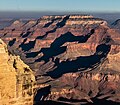Shiva Temple (Grand Canyon)
In 1937, the American Museum of Natural History led explorations to Shiva Temple and Wotans Throne in the belief that these buttes, isolated for 100,000 years from the plateau, may have evolved new species. The scientists discovered Ancestral Puebloan dwellings, deer antlers, and an empty Kodak film box that had been left behind a month earlier by pioneer Emery Kolb, his daughter Edith, Ruth Stephens Baker, Gordon Berger, and Ralph White, but no new species.
According to the Köppen climate classification system, Shiva Temple has a Cold semi-arid climate.
Geology

The top of Shiva Temple is composed of Permian Kaibab Limestone overlaying cream-colored, cliff-forming, Permian Coconino Sandstone. The conspicuous band of sandstone, which is the third-youngest strata in the Grand Canyon, was deposited 265 million years ago as sand dunes. Below the Coconino Sandstone is slope-forming, reddish terraces of the Pennsylvanian-Permian Supai Group. Further down are strata of Mississippian Redwall Limestone, and finally the Cambrian Tonto Group. Precipitation runoff from Shiva Temple drains south to the Colorado River via Trinity and Crystal Creeks.
Prominence – A plateau/tableland
The tableland plateau of Shiva Temple's prominence is made up of a forest of Ponderosa Pine; also pines, junipers, shrubs, and cacti. The animals found in the survey expedition of 1937 were chipmunks, cottontail rabbits, pack rats, mice species, and rock squirrels.
Gallery
See also
References
- ^ "Shiva Temple, Arizona". Peakbagger.com. Retrieved December 22, 2020.
- ^ USGS map, Shiva Temple quadrangle
- ^ "Shiva Temple – 7,646' AZ". Lists of John. Retrieved December 22, 2020.
- ^ "Shiva Temple". Geographic Names Information System. United States Geological Survey, United States Department of the Interior. Retrieved December 22, 2020.
- ^ Boye Lafayette De Mente, The Grand Canyon Answer Book! – Everything You Might Want to Know About the Grand Canyon and Then Some!, 2009, Cultural-Insight Books, ISBN 9780914778097, page 45.
- ^ Randy Moore and Kara Felicia Witt, The Grand Canyon: An Encyclopedia of Geography, History, and Culture, 2018, ABC-CLIO Publisher, page 150.
- ^ Randy Moore and Kara Felicia Witt, The Grand Canyon: An Encyclopedia of Geography, History, and Culture, 2018, ABC-CLIO Publisher, page 151.
- ^ May 29, 1994, Ruth Stephens Baker oral history interview with Karen Underhill, Grand Canyon National Park Museum Collection
- ^ Leavengood, Betty (October 2006). "Ruth Stephens Baker" (PDF). The O'l Pioneer: Quarterly Magazine of the Grand Canyon Historical Society. 17 (4): 3–4.
- ^ Peel, M. C.; Finlayson, B. L.; McMahon, T. A. (2007). "Updated world map of the Köppen−Geiger climate classification". Hydrol. Earth Syst. Sci. 11 (5): 1633. Bibcode:2007HESS...11.1633P. doi:10.5194/hess-11-1633-2007. ISSN 1027-5606.
- ^ N.H. Darton, Story of the Grand Canyon of Arizona, 1917, page 35.
- ^ William Kenneth Hamblin, Anatomy of the Grand Canyon: Panoramas of the Canyon's Geology, 2008, Grand Canyon Association Publisher, ISBN 9781934656013.
- ^ ”Shiva’s Temple”, Arizona, Nature 140 (613)1937 (1937 nature survey expedition) [1]
External links
- Weather forecast: National Weather Service
- American Museum of Natural History Grand Canyon Expedition account: American Alpine Journal
- Shiva Temple aerial photo








